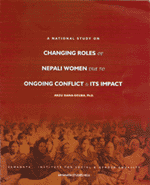A decade of conflict has made many Nepali women more vulnerable yet also forced them to take on traditional male roles because the men in their lives are either absent or at risk, says a new report.
While some of those new roles could be pathways to greater women's empowerment when peace returns, women hope they will be able to discard others.
"The negative effects of the conflict have more far-reaching effects than the positive ones," says Arzu Rana Deuba of Samanata, which conducted the 2004 survey and published the report, Changing Roles of Nepali Women due to the Ongoing Conflict and its Impact. "The negative effects led by growing poverty are totally devastating," she added at a recent presentation in Kathmandu.
Samanta's researchers surveyed Nepalis in nine districts in four development regions. Nearly 90 percent of the respondents were women, 83 percent had families who had moved from villages to district headquarters or cities. More than half of those questioned said they left because they feared for their own or their family's security, because they feared abduction or were searching for work. Most had enough to meet basic needs before the conflict but not after.
Families adjusted by spending less money on food and other basics, except schooling. Still, the survey found that 44 percent of children had dropped out of school. "Mostly children have become very quiet, they're serious, silent and frightened," says Rana Deuba.
Sixty-four percent of those asked said that they and their spouse or a couple that they knew had become separated because of the conflict. Fear of insurgents (33 percent), fear of conflict (32 percent) and fear of death (27 percent) were the main reasons given. Sixteen percent of women were either widows or had no idea where their husband were and were labelled 'half-widows'.
'There was clear perception of increased vulnerability to poverty insecurity, violence,' notes the report which says women are living in constant fear of death, abduction, rape or murder, of themselves, their daughters or daughter-in-laws.
Yet in many cases women reported feeling less vulnerable than men and thus began shouldering their former responsibilities. "They might kill the men, I'm a woman they won't kill me," says Ramila whose story is told in the report. Her family was forced to move from its village in Khotang district to Biratnagar but must return once a year or their claim to their farms would be annulled by the Maoists. 'Ramila now travels alone by bus to Khotang and then walks to the village and back in a day. She negotiates with the insurgents and her self-confidence has increased tremendously. She feels her ability to voice opinions has increased along with awareness about rights,' says the report.
Sixty percent of those interviewed said women had become more active in their communities, 70 percent that they were now borrowing money and two-thirds that women were playing larger roles in decision-making. Nearly two-thirds of men said they had a greater appreciation of the work that women were doing.
The report, which was supported by DfID's Enabling State Programme, concludes: 'It is imperative to consolidate these gains to take forward the development process at a quicker pace. Women's unity and networking in face of adversity should be built upon for initiating the peace process as well as in the reconciliation and reconstruction phase.'
 Changing Roles of Nepali Women due to the Ongoing Conflict and its Impact Samanata: Institute for Social & Gender Equality
Changing Roles of Nepali Women due to the Ongoing Conflict and its Impact Samanata: Institute for Social & Gender Equality
2005
ISBN No. 99946-805-1-X
89 pp (plus annexes)


